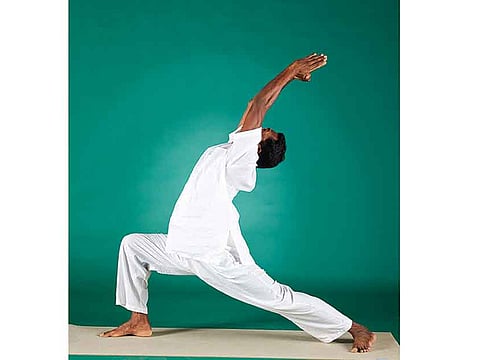The philosophy of yoga
While the practice may be a form of physical exercise, there are also psychological benefits to learning the discipline

In the famous 15th Century yoga manual, Hata Yoga Pradipika, Svami Svatmarama said, “Be it adulthood or in old age, be it in illness or in weakness, if someone does yoga practice properly, he will see good results.”
For Ayurvedic physician and CEO of The Healers’ Clinic Dr Hafeel Ambalath, “Yoga literally means to integrate, join, or unite. It considers people’s body, mind and spirit.”
Dr Hafeel also recognises yoga’s preventive care benefits, referring to its attributes in terms of immunity and core strength building.
The physician alludes to yoga’s many benefits — physically and psychologically, referring to how the practice promotes balanced behaviour and a healthy body and mind. He believes that this is the main similarity between Ayurveda and yoga. Dr Hafeel also sees differences between yoga and Ayurveda, although they are related to the details of both philosophies. “Yoga suggests controlling the mind through detached watchfulness towards our thoughts. It suggests refraining from greed, grief, fear, anger, jealousy, attachment and malice,” he explains. “Ayurveda is a code of conduct for human well-being, which is explained in its core strategy of preventative health care.”
Dr Hafeel and his team have working for the past two decades on an integrative management of health conditions and preventive care called Ayur-Physio. This is approach involves Ayurveda, modern physiotherapy, modern clinical methods and yoga. Here, he sits down with Better Health to discuss the benefits of practicing yoga and its similarities to Ayurveda.
What is the relationship between Ayurveda and yoga?
With Indian origins, Ayurveda and yoga share common philosophies. The commonality is an understanding of the relationship between human beings and their place in the universe. Both Ayurveda and yoga seek alignment between internal and external environments.
Ayurveda focuses more on medicine while yoga is more about the psychological, social and spiritual dimensions of health. The objectives of Ayurveda are more physical, promoting good health for achieving life goals. Yoga is more psychological, where participants are encouraged to experience a state of harmony between their physical and spiritual attributes.
Ayurveda advises practising yoga with a cleansed body and a normalised vayu (movement) and prana. Though there are differences in the cleansing methods, there are more similarities than differences to yoga philosophically. As an Ayurvedic practitioner, I believe Ayurveda helps the body and mind to make practising yoga more fruitful.
Can anybody practice yoga or are therE instances when you wouldn’t recommend it to people?
Yes, there are instances when physical yoga (asanas) is not advised. If you’re nine months’ pregnant, during the first trimester of pregnancy or 30-60 days after delivery, you shouldn’t practice yoga. This also applies if you have a spinal injury, acute intervertebral disc prolapse or are recovering from surgery. Additionally, acute conditions such as an upper respiratory infection, fever and malaise are circumstances where you need to take advice before practising yoga.
What should people consider when selecting a good yoga teacher?
Choose one who has an in-depth understanding of it as a practice and tradition. Most of training is based on yoga’s physical benefits but I would advise people select teachers with the background in other sciences such as Ayurveda or physical therapies, which are holistic in nature.
What are the benefits of learning yoga from a professional instructor?
The more experienced the instructor, the more fruitful the training. In the case of yoga, it takes many years of practice and thorough knowledge of its philosophies to make a perfect instructor. It’s different from other type of sport training.
What’s the biggest misconception about yoga?
“Its not my thing” is the most common comment I come across, which is a misunderstanding. Yoga is for everyone, if it is taught in a person-specific manner. For such guidance, you may require help of an experienced Ayurvedic clinician or yoga practitioner.
“I’m not flexible enough for Yoga” is another mental block. Starting with an experienced guru is the remedy for this. It’s a slow process at first but is also rewarding if you persevere. Another misconception about yoga is that it’s a form of prayer or a religious act, which it isn’t.
What are the common mistakes people tend to make when practising yoga?
Yoga is not a fast sport and the variants you see are not its pure form. The word means a process of union and this happens by discovering yourself through a series of steps. A common mistake is starting with most difficult postures in the beginning, because of existing flexibility. Another mistake is attending large classes, where the instructor doesn’t have an individual understanding of your body. Bad yoga experiences may have negative long-term effects on your body and mind.
If you’re new to yoga, what pose would you recommend people try first?
After an evaluation, our team usually suggest starting with breathing exercises. Breathing brings the awareness and submission you need to be a practitioner. If we are introducing children to yoga, we usually introduce breathing with some animal postures, which they love. Other common postures we usually encourage for healthy individuals are merudandasanam (a leg-raising pose), pavanamuktasana (a wind-release pose) and the palm tree pose, along with some yogic warm-ups.
How quickly can someone expect to improve if they practice regularly?
If you start practising yoga correctly, you should start to improve with just a week’s practice. Three months of regular practice is a more sustainable time as yoga will become part of your healthy lifestyle routine.
— Thehealersclinic.com | 04 385 5677
Sign up for the Daily Briefing
Get the latest news and updates straight to your inbox
